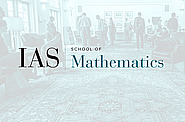Seminars
Mar
09
2015
Computer Science/Discrete Mathematics Seminar I
Strong contraction and influences in tail spaces
Elchanan Mossel
11:15am|West Bldg. Lect. Hall
Mar
03
2015
Computer Science/Discrete Mathematics Seminar II
Whitney numbers via measure concentration in representation varieties
Karim Adiprasito
10:30am|S-101
Mar
02
2015
Computer Science/Discrete Mathematics Seminar I
Effective-resistance-reducing flows, spectrally thin trees and asymmetric TSP
Shayan Oveis Gharan
12:30pm|S-101
Feb
24
2015
Feb
23
2015
Computer Science/Discrete Mathematics Seminar I
Lower bounds for clique vs. independent set
11:15am|S-101
Feb
17
2015
Computer Science/Discrete Mathematics Seminar II
The log-concavity conjecture and the tropical Laplacian
10:30am|S-101
Feb
16
2015
Computer Science/Discrete Mathematics Seminar I
2-Server PIR with sub-polynomial communication
Sivakanth Gopi
11:15am|S-101
Feb
10
2015
Computer Science/Discrete Mathematics Seminar II
How to round subspaces: a new spectral clustering algorithm
10:30am|S-101
Feb
09
2015
Computer Science/Discrete Mathematics Seminar I
Quantum Computing with Noninteracting Particles
Alex Arkhipov
11:15am|Simonyi Hall, Room 101
Feb
09
2015
Computer Science/Discrete Mathematics Seminar I
Quantum computing with noninteracting particles
Alex Arkhipov
11:15am|S-101
